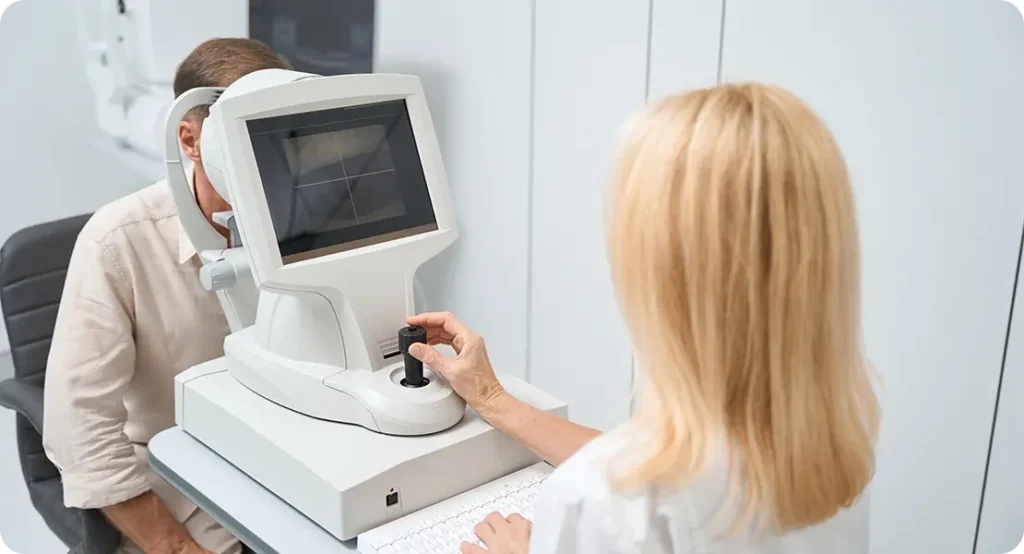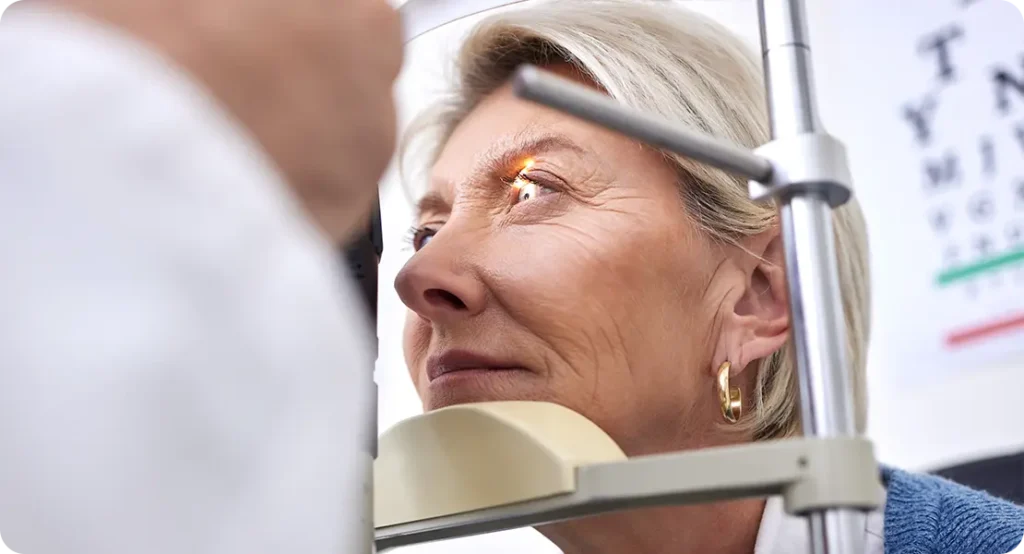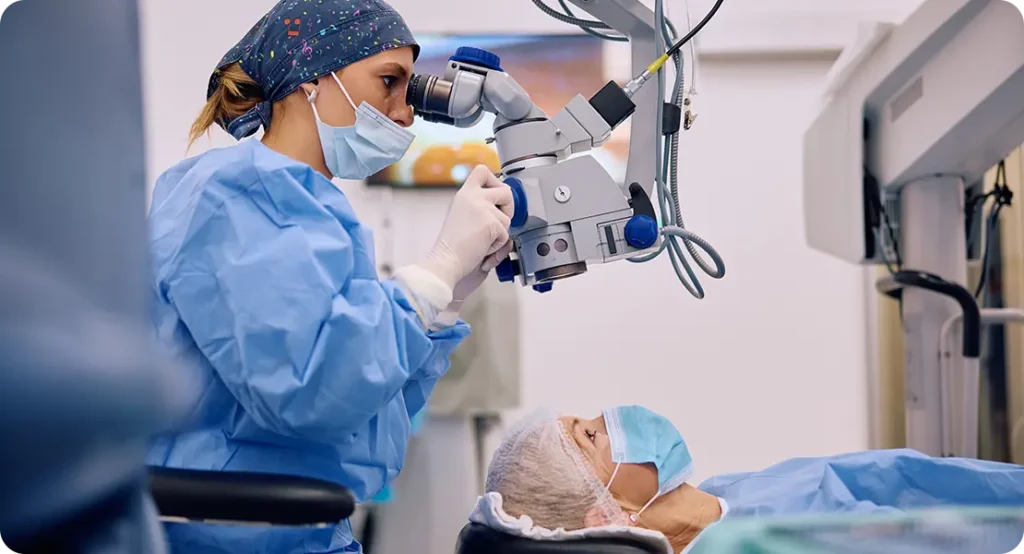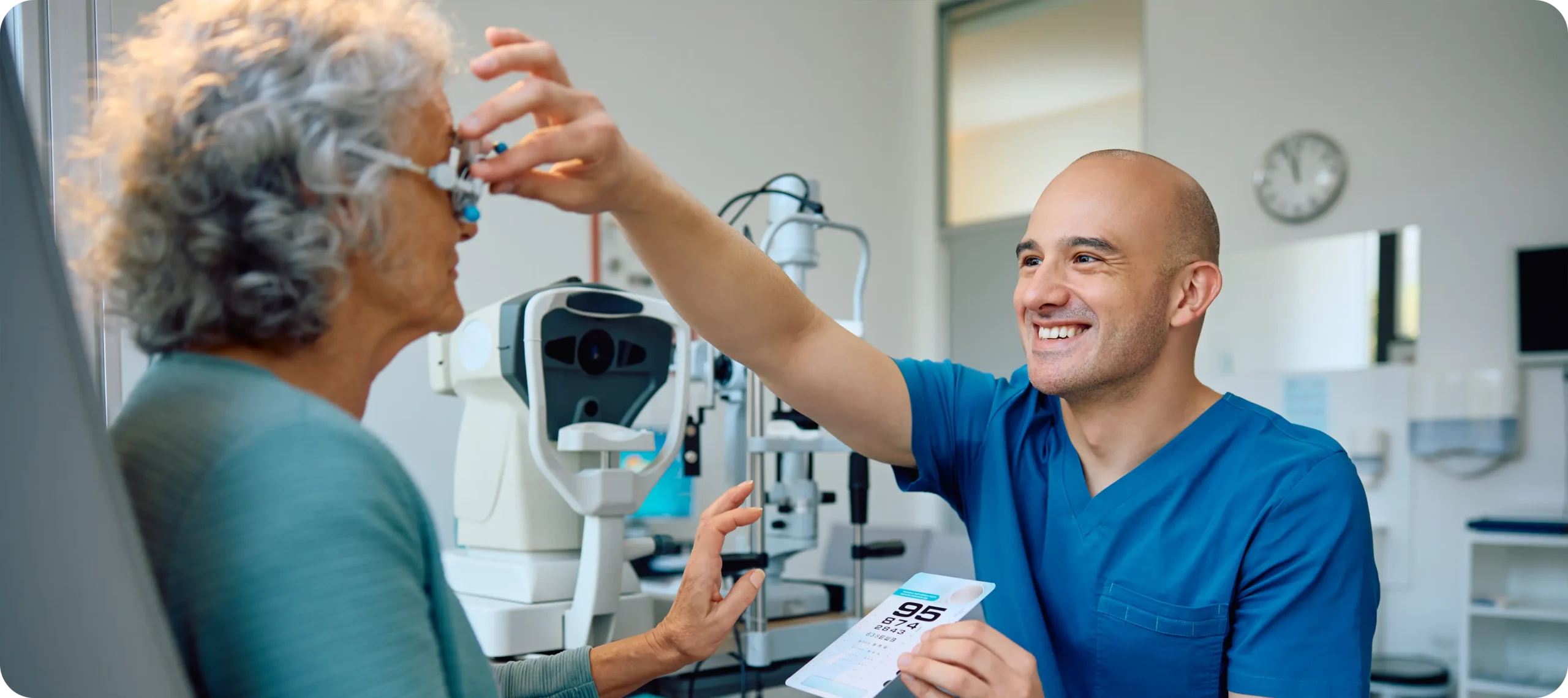Cataract surgery is one of the most common and effective procedures performed worldwide to restore vision impaired by cataracts. While the surgery itself is relatively quick, the preoperative process plays a crucial role in ensuring a successful outcome. This guide outlines the essential steps patients need to follow before undergoing cataract surgery.
1. Initial Consultation and Diagnosis
The journey towards cataract surgery begins with a thorough eye examination conducted by an ophthalmologist or optometrist. This step is crucial in determining the severity of the cataract and ensuring that surgery is the best course of action. The consultation typically involves a series of detailed tests to assess overall eye health and vision clarity.
- Visual Acuity Test: This test evaluates how well a patient can see at various distances by reading letters on a standard eye chart. It helps determine the level of vision impairment caused by the cataract.
- Slit-Lamp Examination: A specialised microscope with a bright light is used to examine the structures of the eye, including the cornea, iris, and lens. This allows the doctor to identify cataracts and detect any additional abnormalities such as corneal disease or inflammation.
- Retinal Examination: By dilating the pupils with eye drops, the doctor gains a clearer view of the retina and optic nerve at the back of the eye. This is essential for identifying co-existing conditions such as macular degeneration or diabetic retinopathy, which could influence surgical decisions.
- Tonometry: This test measures intraocular pressure (IOP) to check for glaucoma, a condition that can affect vision and may need to be managed before proceeding with cataract surgery.
- Contrast Sensitivity Test: This additional test assesses how well a patient can distinguish objects from their background, especially in low-light conditions. Cataracts can significantly reduce contrast sensitivity, making activities such as driving at night more challenging.
- Glare Test: Some patients with cataracts experience significant glare sensitivity, particularly in bright sunlight or oncoming headlights at night. This test helps quantify the impact of glare on vision.
- Colour Vision Test: In some cases, cataracts can cause colours to appear faded or yellowed. This test evaluates any changes in colour perception, helping the doctor understand the extent of visual distortion.
Following these assessments, the doctor will discuss the findings with the patient. If the cataract is mild and not significantly affecting daily activities, the doctor may recommend monitoring its progression over time with regular check-ups. However, if the cataract is substantially impairing vision and interfering with daily life—such as reading, driving, or recognising faces—surgery will be recommended as the most effective solution. Patients will also have the opportunity to ask questions, express concerns, and learn more about the surgical process during this consultation.
In some cases, patients with cataracts in both eyes may be advised to have surgery on one eye first, allowing for recovery before addressing the second eye. Additionally, the consultation provides an opportunity to discuss any lifestyle needs and visual goals, which will influence the selection of an intraocular lens (IOL) during the preoperative planning stage.

2. Preoperative Measurements and Lens Selection
Once the decision for surgery is made, detailed measurements of the eye are taken to determine the appropriate intraocular lens (IOL) power and type. These measurements ensure that the replacement lens provides optimal visual clarity and reduces dependence on glasses post-surgery. The precision of these calculations is essential for achieving the best possible surgical outcome.
Key Preoperative Measurements
A variety of tests are conducted to map the eye’s structure and ensure the most accurate lens prescription:
- Biometry: This is one of the most critical tests, using optical coherence biometry (OCB) or ultrasound techniques to measure the axial length of the eye and the curvature of the cornea. These measurements help calculate the exact power of the IOL required to replace the clouded natural lens.
- Corneal Topography: This test creates a detailed map of the corneal surface to identify irregularities or astigmatism. Patients with significant astigmatism may require special toric lenses to correct it, ensuring sharper vision post-surgery.
- Keratometry: This test measures the curvature of the cornea’s anterior surface, helping determine how the eye focuses light. The results play a crucial role in selecting the appropriate lens type.
- Pupil Size Measurement: The size of the pupil in different lighting conditions is assessed to determine how well the selected IOL will function in various environments. Some lenses perform better for patients with larger or smaller pupils.
- Anterior Chamber Depth Measurement: The depth of the space between the cornea and the lens is evaluated to help in the selection of the most suitable IOL design.
- Wavefront Aberrometry: This test evaluates higher-order aberrations in the eye, which can influence visual quality. It helps in choosing advanced IOLs that reduce visual distortions.

Selecting the Right Intraocular Lens (IOL)
After completing these measurements, the surgeon discusses the available lens options with the patient. Choosing the right IOL is crucial, as it affects the patient’s vision quality and lifestyle after surgery. The available lenses include:
- Monofocal Lenses: These lenses provide clear vision at a single fixed distance—either near, intermediate, or far. Most patients choose to have their monofocal lens set for distance vision and wear reading glasses for near tasks.
- Multifocal Lenses: Designed to provide good vision at multiple distances, these lenses reduce the need for glasses. However, some patients may experience glare or halos, especially at night.
- Extended Depth of Focus (EDOF) Lenses: These lenses offer an extended range of vision, reducing dependency on glasses while minimising visual disturbances like halos and glare.
- Toric Lenses: Specially designed for patients with astigmatism, toric lenses correct corneal irregularities, providing sharper and clearer vision.
- Accommodating Lenses: These lenses move naturally within the eye to shift focus between distances, mimicking the function of a young, healthy lens.
Factors Influencing IOL Selection
The choice of lens depends on multiple factors, including:
- Lifestyle Needs: Patients who engage in activities requiring precise vision at different distances, such as reading, driving, or using digital devices, may benefit from multifocal or EDOF lenses.
- Budget Considerations: While monofocal lenses are typically covered by insurance or NHS services, premium lenses like multifocal or toric options may involve additional costs.
- Personal Vision Preferences: Some patients prioritise the sharpest possible distance vision, while others prefer the convenience of reduced dependence on glasses.
- Existing Eye Conditions: Patients with retinal issues, dry eye syndrome, or other eye diseases may not be suitable candidates for multifocal or EDOF lenses and may achieve better outcomes with monofocal or toric options.
3. Preoperative Medical Evaluation
A thorough preoperative medical evaluation is essential to ensure the patient is fit for cataract surgery. While cataract surgery is a minimally invasive and generally low-risk procedure, underlying health conditions can affect both the surgical outcome and the healing process. This evaluation helps identify any potential risks and ensures that necessary precautions are taken.
Comprehensive Medical History Review
The first step in the preoperative assessment is a detailed review of the patient’s medical history. This includes discussions about:
- Chronic Conditions: Patients with conditions such as diabetes, hypertension, or cardiovascular disease require careful management before surgery. Uncontrolled blood sugar or high blood pressure can increase the risk of complications during and after the procedure.
- Previous Surgeries and Anaesthesia Reactions: A history of complications with previous surgeries, including allergic reactions to anaesthesia or difficulties with healing, will be considered in surgical planning.
- Eye-Related Conditions: Other eye conditions, such as glaucoma, macular degeneration, or dry eye syndrome, may affect the choice of intraocular lens (IOL) or require additional treatment before or after surgery.
- Use of Blood Thinners: Patients taking anticoagulants such as warfarin, aspirin, or clopidogrel may need adjustments to their medication regimen to minimise the risk of excessive bleeding.
Laboratory and Diagnostic Tests
Depending on the patient’s overall health and medical history, the doctor may order several tests to assess their fitness for surgery:
- Blood Tests: These may include a complete blood count (CBC) to check for anaemia or infection, as well as kidney and liver function tests for patients with chronic illnesses.
- Blood Sugar Levels: For diabetic patients, blood glucose levels and HbA1c tests help determine whether their diabetes is well controlled before surgery.
- Electrocardiogram (ECG): Patients with a history of heart disease or irregular heart rhythms may require an ECG to ensure their heart is in a stable condition for the surgery.
- Blood Pressure Monitoring: If a patient has hypertension, their blood pressure should be well-managed before surgery to reduce the risk of complications during the procedure.
- Lung Function Tests: Patients with respiratory conditions such as asthma or chronic obstructive pulmonary disease (COPD) may need lung function assessments to ensure they can tolerate the mild sedation used during cataract surgery.

Medication Review and Adjustments
Certain medications may need to be adjusted or temporarily discontinued before surgery to reduce risks. The surgeon and anaesthetist will provide specific guidance on:
- Anticoagulants and Blood Thinners: Patients taking warfarin, heparin, or aspirin may need to pause or modify their dosage to prevent excessive bleeding during surgery. However, stopping these medications completely may not be safe for all patients, and the decision is made on a case-by-case basis.
- Diabetes Medication: Since patients are often required to fast before surgery, adjustments may be needed to prevent low blood sugar levels (hypoglycaemia). Insulin dosages or oral diabetes medications may be modified based on the surgical schedule.
- Blood Pressure Medication: Some antihypertensive drugs, particularly ACE inhibitors and diuretics, may be temporarily adjusted to avoid fluctuations in blood pressure during the procedure.
- Steroid Use: Patients on long-term steroid therapy for conditions such as rheumatoid arthritis or asthma may need additional monitoring, as steroids can impact wound healing and increase the risk of infection.
- Over-the-Counter Medications and Supplements: Certain herbal supplements, including ginkgo biloba, garlic, and fish oil, can increase bleeding risk and may need to be stopped before surgery.
Preoperative Eye Examination and Ocular Health Assessment
Apart from systemic health evaluations, a thorough preoperative eye assessment ensures the eyes are in optimal condition for surgery. This may include:
- Tear Film Assessment: Patients with dry eyes may require additional preoperative treatment to improve tear quality, as dry eyes can affect post-surgical comfort and healing.
- Ocular Surface Examination: Any existing eye infections, inflammation, or conditions like blepharitis need to be treated before surgery to reduce the risk of postoperative complications.
- Intraocular Pressure (IOP) Measurement: If a patient has glaucoma or borderline high eye pressure, additional precautions may be taken during surgery to manage IOP.
Final Preoperative Clearance and Surgical Plan
After completing the medical evaluation, the patient’s healthcare team will determine whether they are fit for surgery. If any health concerns are identified, they may need further medical management or specialist consultation before proceeding. In some cases, surgery may be postponed until conditions such as uncontrolled diabetes or hypertension are stabilised.
By ensuring all medical and ocular conditions are well managed before cataract surgery, the risk of complications is minimised, leading to a smoother procedure and better visual outcomes for the patient.
4. Medication Adjustments and Instructions
Patients are given specific guidelines on medications before surgery, such as:
- Blood Thinners: Some anticoagulants may need to be paused or adjusted to reduce the risk of bleeding.
- Diabetes Medication: Dosage modifications may be required on the day of surgery to prevent fluctuations in blood sugar levels.
- Eye Drops: Antibiotic or anti-inflammatory eye drops are often prescribed to be used in the days leading up to surgery to reduce infection risk.

5. Lifestyle Preparations
Certain lifestyle adjustments help ensure a smooth surgical experience:
- Fasting Requirements: Patients are usually advised to refrain from eating or drinking for several hours before surgery.
- Arranging Transportation: Since vision will be temporarily affected, a friend or family member should accompany the patient.
- Hygiene and Skincare: On the day of surgery, patients should avoid wearing makeup, perfumes, or facial creams to reduce the risk of contamination.
6. Pre-Surgery Discussion and Consent
Before undergoing cataract surgery, patients have a final consultation with their surgeon to review the procedure in detail and ensure they fully understand what to expect. This discussion is a crucial step in the preoperative process, allowing patients to make informed decisions and voice any last-minute concerns.
Key Discussion Points Covered
During this session, the surgeon provides a comprehensive overview of the surgery, addressing the following topics:
- The Cataract Surgery Procedure: The surgeon explains the step-by-step process, including how the cloudy natural lens will be removed and replaced with an artificial intraocular lens (IOL). Patients are informed about the type of anaesthesia used (typically local anaesthesia with sedation) and how long the procedure is expected to take.
- Risks and Benefits of Surgery: While cataract surgery is one of the safest and most commonly performed procedures, it is important to discuss potential risks. These may include infection, inflammation, increased intraocular pressure, or complications related to the replacement lens. The surgeon also explains the benefits, such as improved vision, reduced dependence on glasses, and enhanced quality of life.
- Expected Outcomes: Patients receive a realistic understanding of their post-surgical vision. The surgeon clarifies whether they will still need glasses for certain activities and how long it may take for vision to stabilise.
- Potential Complications: While rare, complications such as posterior capsule opacification (a condition that may cause blurred vision months or years after surgery), retinal detachment, or swelling in the retina are discussed. Patients are advised on the warning signs of complications and when to seek medical attention.
- Recovery and Postoperative Care: The surgeon outlines the expected recovery timeline, explaining when normal activities can be resumed and what precautions should be taken in the first few weeks after surgery. Instructions on using prescribed eye drops, avoiding strenuous activities, and protecting the eyes from irritants such as dust and bright light are also provided.
Addressing Patient Questions and Concerns
Patients are encouraged to ask any questions they may have about the procedure, recovery, or lens options. Common questions include:
- Will I feel any pain during the procedure?
- How long will it take for my vision to improve?
- What happens if I move my eye during surgery?
- Can cataracts return after surgery?
- Will I still need glasses after getting an IOL?
This discussion ensures that patients have clear expectations and feel confident about their upcoming surgery.
Consent Form and Legal Considerations
After the discussion, patients are given a consent form, which they must read and sign. This form serves as a legal document confirming that:
- The patient has been informed about the procedure, risks, and benefits.
- They understand the potential complications and alternative treatment options.
- They agree to proceed with cataract surgery with full knowledge of the process.
Some medical facilities may also require patients to sign an additional form specifying their chosen IOL type, especially if opting for premium lenses that are not covered by standard insurance plans.
Final Preparations Before Surgery
Following consent, patients receive their final preoperative instructions, which may include:
- A reminder about fasting guidelines before surgery.
- Confirmation of their arrival time at the surgical centre.
- The need for a companion to accompany them home post-surgery.
- Any additional medication adjustments required before the procedure.
By completing this step, patients can proceed to surgery with confidence, knowing they are fully informed and prepared for the process ahead.
7. Preparing for the Day of Surgery
The day of cataract surgery is a crucial milestone in the journey to restored vision. Proper preparation ensures a smooth experience and minimises any potential stress. Patients should follow all preoperative instructions carefully to ensure the best possible surgical outcome.

Key Preparations Before Leaving Home
- Wear Comfortable Clothing: It is advisable to wear loose-fitting, comfortable clothing with a button-up or zip-up front. This makes it easier to change without pulling anything over the head, reducing the risk of disturbing the eye area post-surgery.
- Avoid Makeup, Lotions, and Fragrances: Patients should refrain from wearing makeup, facial creams, or perfumes on the day of surgery. Residues from cosmetics or skincare products can increase the risk of infection or interfere with surgical instruments.
- Remove Contact Lenses (if applicable): If patients wear contact lenses, they should follow their surgeon’s instructions regarding when to discontinue use before surgery. In most cases, patients are advised to switch to glasses a few days prior to the procedure.
- Follow Fasting Instructions: Depending on the type of anaesthesia used, patients may need to avoid eating or drinking for a specified period before surgery, typically six to eight hours. This helps prevent nausea or complications related to sedation.
- Take Medications as Directed: Patients should follow their doctor’s advice regarding medications. Some prescriptions, such as those for blood pressure or heart conditions, may still need to be taken with a small sip of water, while others, like blood thinners, may have been temporarily adjusted.
What to Bring to the Surgical Centre
- Identification and Medical Records: Patients should carry their ID, insurance details, and any necessary medical documents, including test results or referral letters.
- Surgical Paperwork and Consent Forms: Any pre-signed consent forms or hospital paperwork should be brought along to expedite the check-in process.
- List of Medications: A list of current medications, including dosages, should be provided to the surgical team in case any adjustments are needed.
- Sunglasses or Protective Eyewear: Since the eyes will be sensitive to light after surgery, wearing sunglasses on the way home will help protect against glare and discomfort.
- A Companion or Arranged Transport: Patients are not allowed to drive immediately after surgery due to blurred vision and lingering effects of sedation. A friend, family member, or caregiver should accompany them and drive them home safely.
- A Small Bag with Essentials: A simple bag with tissues, a bottle of water (if permitted), and any comfort items can be helpful while waiting.
Arrival at the Surgical Centre
- Arrive Early: Patients are typically asked to arrive 30 to 60 minutes before the scheduled surgery to complete any last-minute paperwork and undergo final preoperative assessments.
- Pre-Surgical Check-In: Nurses or medical staff will confirm details, check vital signs such as blood pressure, and ensure the patient is ready for the procedure.
- Eye Marking and Verification: In some clinics, the eye to be operated on may be marked to avoid any confusion, and the surgical team will reconfirm the procedure details.
- Administration of Eye Drops: Special antibiotic and dilating eye drops will be administered to prepare the eye for surgery and reduce the risk of infection.
- Discussion with the Anaesthesia Team: If sedation or local anaesthesia is being used, the anaesthesia team will explain what to expect and address any last-minute concerns.
Final Moments Before Surgery
Once all preparations are complete, the patient is taken to the operating room. They will be made comfortable in a reclining position, and the surgical team will ensure everything is set for a smooth and successful procedure.
By following these guidelines, patients can approach their cataract surgery with confidence, knowing they have taken all necessary steps to ensure a safe and stress-free experience.

Conclusion
The preoperative process for cataract surgery is an important step in ensuring the best possible outcome. From the initial diagnosis and choosing the right lens to medical evaluations and making necessary lifestyle adjustments, each part of the process helps you prepare for a smooth surgical experience. By following these guidelines, you can approach your cataract surgery with confidence, knowing you’ve taken all the necessary steps for a successful procedure and recovery.

